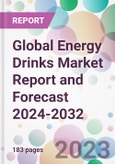According to the report, the global energy drinks market is projected to grow at a CAGR of 7.10% between 2024 and 2032. Aided by the evolving consumer lifestyles and the growing demand for functional beverages, the market is poised for robust growth, the market is expected to grow significantly by 2032.
Energy drinks have surged in popularity as they offer a quick boost of energy, enhanced mental alertness, and improved physical performance. Typically containing caffeine, vitamins, and other stimulants, these beverages have become a staple for consumers seeking an instant energy uplift. They are particularly popular among athletes, students, professionals, and individuals leading an active lifestyle.
The growing consumer preference for convenience and on-the-go consumption is a significant driver for the energy drinks market growth. In today's fast-paced world, consumers are increasingly seeking products that offer quick and efficient energy boosts to cope with their busy schedules. This trend has led to a surge in the demand for energy drinks.
In addition to their energising properties, many energy drinks are also fortified with vitamins, amino acids, and herbal extracts, making them appealing to health-conscious consumers. This aspect of health and wellness has contributed significantly to the growing popularity of energy drinks.
The energy drinks market outlook is further influenced by the innovative product offerings and flavour diversification. Companies are continually experimenting with new ingredients, formulations, and packaging to attract consumers and cater to diverse taste preferences.
Marketing and branding strategies also play a pivotal role in propelling the energy drinks market. Many brands have successfully positioned themselves as essential beverages for an active and dynamic lifestyle, appealing to a broad consumer base. Sponsorship of sports events, strategic endorsements, and engaging marketing campaigns have enhanced the visibility and appeal of energy drinks.
There is a growing demand for energy drinks with reduced sugar, natural ingredients, and alternative sources of caffeine. The emergence of organic and natural energy drinks caters to the health-conscious segment of the market, thus broadening the consumer base.
Additionally, the rise of the functional beverage segment offers ample opportunities for energy drinks to incorporate additional health benefits, such as improved digestion, immune support, and stress relief. This integration of functionality and energy enhancement can further increase energy drinks market share.
Energy drinks have surged in popularity as they offer a quick boost of energy, enhanced mental alertness, and improved physical performance. Typically containing caffeine, vitamins, and other stimulants, these beverages have become a staple for consumers seeking an instant energy uplift. They are particularly popular among athletes, students, professionals, and individuals leading an active lifestyle.
The growing consumer preference for convenience and on-the-go consumption is a significant driver for the energy drinks market growth. In today's fast-paced world, consumers are increasingly seeking products that offer quick and efficient energy boosts to cope with their busy schedules. This trend has led to a surge in the demand for energy drinks.
In addition to their energising properties, many energy drinks are also fortified with vitamins, amino acids, and herbal extracts, making them appealing to health-conscious consumers. This aspect of health and wellness has contributed significantly to the growing popularity of energy drinks.
The energy drinks market outlook is further influenced by the innovative product offerings and flavour diversification. Companies are continually experimenting with new ingredients, formulations, and packaging to attract consumers and cater to diverse taste preferences.
Marketing and branding strategies also play a pivotal role in propelling the energy drinks market. Many brands have successfully positioned themselves as essential beverages for an active and dynamic lifestyle, appealing to a broad consumer base. Sponsorship of sports events, strategic endorsements, and engaging marketing campaigns have enhanced the visibility and appeal of energy drinks.
There is a growing demand for energy drinks with reduced sugar, natural ingredients, and alternative sources of caffeine. The emergence of organic and natural energy drinks caters to the health-conscious segment of the market, thus broadening the consumer base.
Additionally, the rise of the functional beverage segment offers ample opportunities for energy drinks to incorporate additional health benefits, such as improved digestion, immune support, and stress relief. This integration of functionality and energy enhancement can further increase energy drinks market share.
Market Segmentation
The market can be divided based on product, type, consumer, distribution channel, and region.Market Breakup by Product
- Non-Alcoholic Energy Drinks
- Alcoholic Energy Drinks
Market Breakup by Type
- Non-Organic Energy Drinks
- Organic Energy Drinks
- Natural Energy Drinks
Market Breakup by Consumer
- Teenagers
- Adults
- Geriatric Population
Market Breakup by Distribution Channel
- On-Trade Distribution
- Off-Trade & Direct Selling Distribution
Market Breakup by Region
- North America
- Europe
- Asia Pacific
- Latin America
- Middle East and Africa
Competitive Landscape
The report looks into the market shares, plant turnarounds, capacities, investments, and mergers and acquisitions, among other major developments, of the leading companies operating in the global energy drinks market. Some of the major players explored in the report are as follows:- Red Bull GmBH
- Monster Beverage Corporation
- National Beverage Corp.
- The Coca-Cola Company
- Pepsico Inc.
- Arizona Beverage Co.
- Others
Table of Contents
1 Preface2 Report Coverage - Key Segmentation and Scope4 Key Assumptions7 Opportunities and Challenges in the Market15 Value Chain Analysis17 Key Trends and Developments in the Market
3 Report Description
5 Executive Summary
6 Snapshot
8 Global Energy Drinks Market Analysis
9 North America Energy Drinks Market Analysis
10 Europe Energy Drinks Market Analysis
11 Asia Pacific Energy Drinks Market Analysis
12 Latin America Energy Drinks Market Analysis
13 Middle East and Africa Energy Drinks Market Analysis
14 Market Dynamics
16 Competitive Landscape
List of Key Figures and Tables
Companies Mentioned
- Red Bull GmBH
- Monster Beverage Corporation
- National Beverage Corp.
- The Coca-Cola Company
- Pepsico Inc.
- Arizona Beverage Co. Others
Methodology

LOADING...








